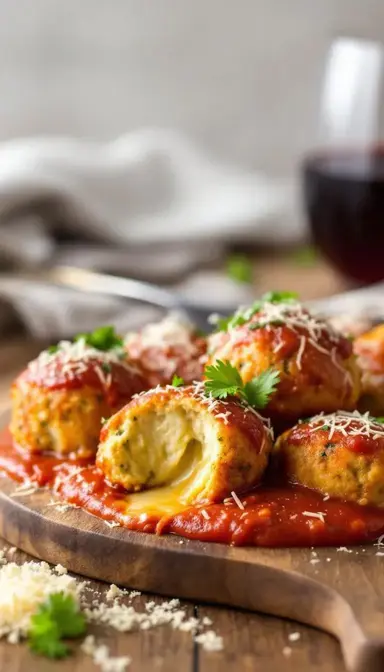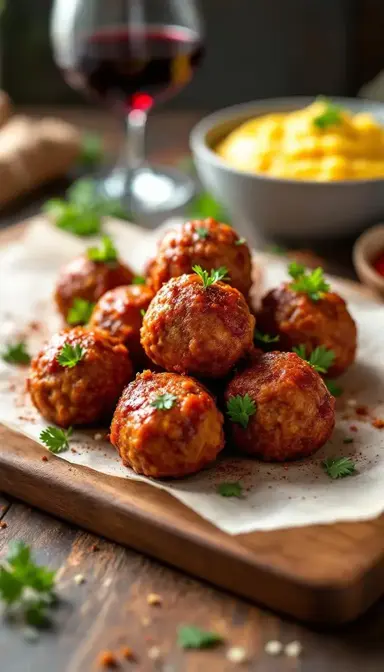Let me tell you about the first time I tasted real Danish frikadeller. It was in a cozy Copenhagen kitchen, where the scent of sizzling pork and beef patties mingled with laughter and the sharp tang of mustard sauce. That moment taught me something important – the best comfort food isn’t about fancy techniques or rare ingredients. It’s about dishes like these tender meat patties that somehow taste like home, even if you didn’t grow up in Denmark.
These golden-brown beauties with their creamy mustard sauce are what I call “weeknight magic” – simple enough for Tuesday dinner but special enough for Sunday supper with friends. The secret? That perfect balance between a crispy crust and a juicy interior that makes you close your eyes after the first bite. And that sauce? It’s like the Danish answer to gravy, but with personality – tangy, rich, and impossible not to swipe your finger through when no one’s looking.
Why This Recipe Works
- Simple ingredients, extraordinary results: Like turning a basic chord progression into a beautiful song. The panade (bread-milk paste) keeps the patties tender, while the mustard sauce adds a tangy contrast.
- Meal prep hero: Make a double batch and freeze some for those “I can’t even” evenings. The patties freeze beautifully, though the sauce is best made fresh.
- Kid-tested, grandparent-approved: The universal language of deliciousness. Mild enough for picky eaters but flavorful enough to impress.
The Story Behind the Sauce
Frikadeller tell the story of Danish ingenuity – how to make humble ingredients sing. Originally a way to stretch precious meat with bread, they’ve become a national treasure. My Danish friend Mette once told me, “If there’s no frikadeller at the table, is it even a family gathering?” That’s how deeply these are woven into the culture. The combination of pork and beef reflects Denmark’s farming heritage, while the mustard sauce shows their love for bold, simple flavors.
Essential Ingredients & Tools
Ingredients for the Frikadeller
- 1 lb (450g) ground pork: The fatty kind – this isn’t the time for lean (shoulder or butt cuts work best).
- ½ lb (225g) ground beef (80/20): Think juicy burger vibes. Avoid lean blends – fat equals flavor here.
- 1 medium yellow onion: Grated so fine it practically disappears (use a box grater or food processor).
- 1 large egg: The glue that holds our deliciousness together.
- ½ cup (120ml) milk: For soaking our bread like it’s at a spa (whole milk preferred).
- ½ cup (30g) plain breadcrumbs or 2 slices stale bread: Texture magic (stale bread absorbs better).
- 2 tbsp all-purpose flour: The silent supporter that helps bind everything.
- 1½ tsp salt: The difference between “meh” and “more please”.
- ½ tsp white pepper: That subtle Danish touch (black pepper works in a pinch).
- ¼ tsp ground nutmeg: The secret whisper of warmth (freshly grated if possible).
Ingredients for the Mustard Sauce
- 2 tbsp (30g) butter: Because everything starts with butter.
- 2 tbsp all-purpose flour: Our thickening friend.
- 1½ cups (360ml) beef or vegetable broth: Flavor foundation (low-sodium preferred).
- 3 tbsp Danish-style mustard: Maille Old Style if you can find it (Dijon works as a substitute).
- ¼ cup (60ml) heavy cream: The velvet touch (half-and-half can substitute in a pinch).
Tools You’ll Need
- Large mixing bowl: For the meat party.
- 10–12 inch skillet: Non-stick or cast iron – your choice (cast iron gives better browning).
- Whisk: For sauce smoothness.
- Box grater or food processor: For onion tears (a knife works but takes longer).
Serves: 4–5 hungry people | Prep: 25 min | Cook: 25 min | Total: 50 min
How to Make Danish Frikadeller with Mustard Sauce
- Create the Panade (Our Secret Weapon)
Mix ½ cup (30g) breadcrumbs and ½ cup (120ml) milk in a small bowl and let it sit for 5–10 minutes. This creates what chefs call a panade – basically a bread pudding that keeps our meat tender by preventing the proteins from tightening too much during cooking. Mash it until it looks like oatmeal that’s had a rough day.
- Meat Mixing Time
In your big bowl, gently crumble 1 lb (450g) ground pork and ½ lb (225g) ground beef like you’re handling fragile dreams. Add 1 medium grated yellow onion, 1 large egg, 1½ tsp salt, ½ tsp white pepper, and ¼ tsp ground nutmeg. Now fold it all together like you’re tucking in a blanket – no aggressive stirring unless you want hockey pucks. Overmixing activates proteins called myosin, leading to tough patties.
- Bring in the Panade
Add your bread-milk mixture and sprinkle 2 tbsp all-purpose flour over the top. Fold gently until just combined – we’re making patties, not mortar. The mix should feel like it’s barely holding together – that’s perfect. Stop as soon as no dry streaks remain.
- Shape Your Masterpieces
Wet your hands (trust me, this prevents sticking) and scoop about 3 tablespoons of mix. Shape into slightly flattened ovals about ¾-inch thick. The oval shape ensures even cooking – the thinner ends crisp up while the thicker center stays juicy.
- Chill Out (The Patties, Not You)
Pop them in the fridge for 15–30 minutes. This firms up the fat, reducing the risk of breakage during frying. It’s especially helpful if you’re new to shaping meat patties.
- Pan-Fry to Golden Perfection
Medium heat is key here – we want that perfect golden crust without burning (about 325°F if using a thermometer). Cook for 4–5 minutes per side without pressing (juice thieves!). They’re done at 160°F inside, but remember they’ll continue cooking slightly from residual heat.
- Whip Up That Mustard Sauce
In the same pan (flavor town!), melt 2 tbsp (30g) butter, whisk in 2 tbsp all-purpose flour to make a roux, then slowly add 1½ cups (360ml) broth while whisking constantly to prevent lumps. Simmer until thickened enough to coat the back of a spoon (3–4 minutes), then stir in 3 tbsp Danish-style mustard and ¼ cup (60ml) heavy cream. Taste and try not to drink it straight.
- Serve with Love
Arrange your frikadeller on a platter and either drizzle with sauce or let everyone dunk. Garnish with parsley if you’re feeling fancy. The traditional Danish way is to serve them nestled right into the sauce.
Pro Technique
The Panade Principle
This bread-milk paste is like an insurance policy against dry patties. The starch molecules in the bread absorb moisture during cooking, then release it back into the meat as it rests. Stale bread works best because it’s more absorbent than fresh.
Heat Matters
Medium heat is the sweet spot. Too hot (above 350°F) and you’ll have charcoal outsides and raw insides. Too low (under 300°F) and they’ll steam instead of sear. Listen for a gentle sizzle – it should sound content, not angry.
Shape for Success
Oval patties cook more evenly than round ones because the shape allows for consistent thickness. The ¾-inch thickness ensures they cook through without drying out – any thicker and the centers may stay raw; any thinner and they risk becoming dry.
Chef’s Wisdom
Overmixing the Meat
This isn’t kneading dough. Gentle folds only, or you’ll end up with dense, tough patties that resemble sausage more than tender frikadeller.
Skipping the Chill
I know, I know – you’re hungry. But those 15 minutes in the fridge mean the difference between perfect patties and a crumbly mess. The cold helps the fat firm up so the patties hold their shape during cooking.
Sauce Lumps
If your sauce gets lumpy, don’t panic. A quick strain through a fine-mesh sieve or blend with an immersion blender will fix it. Next time, add the broth slowly while whisking like your life depends on it – start with just a few tablespoons to create a smooth paste before adding the rest.
Storage & Freshness Guide
Cooked Frikadeller
They’ll keep in an airtight container in the fridge for 3 days. Reheat gently in a skillet with a splash of broth to keep them moist – the steam helps revive them without drying out.
Uncooked Patties
Freeze them on a parchment-lined tray first (1–2 hours), then transfer to a freezer bag. They’ll keep for 3 months. Cook from frozen, adding 2–3 extra minutes per side.
Mustard Sauce
Best fresh, but will keep for 1–2 days in the fridge. Reheat gently with a splash of cream to bring it back to life. Avoid freezing – dairy-based sauces often separate when thawed.
Nutrition Profile
- Calories: 580
- Protein: 32g
- Carbohydrates: 20g
- Fat: 42g
- Fiber: 1g
Ingredient Variations and Their Impact
All-Pork Version
Use 1.5 lbs of ground pork for a richer, more traditional taste. Pork shoulder with about 25% fat content works beautifully here.
Gluten-Free
Swap in gluten-free breadcrumbs and use cornstarch instead of flour. Add a teaspoon of xanthan gum to help bind everything together.
Herb Boost
Mix in 2 tbsp chopped fresh parsley or dill to the meat mixture for a bright flavor pop. For extra depth, brown the herbs in butter before adding.
Perfect Pairings
Complementary Dishes
- Buttered Potatoes: The creamy, mild flavor of boiled potatoes tossed in butter lets the frikadeller shine. For texture contrast, try pan-frying the potatoes until crispy.
- Braised Red Cabbage: The sweet-and-sour notes of this classic Danish side cut through the richness of the meat and sauce.
Drinks
- Danish Pilsner: A crisp, light beer like Carlsberg cleanses the palate between bites.
- Dry Riesling: The wine’s acidity balances the mustard sauce, while its fruitiness complements the pork.
Something Sweet
- Apple Compote: Serve warm spiced apples on the side for a traditional Danish finish.
- Vanilla Ice Cream with Lingonberry Jam: The tart jam echoes the mustard’s tang, while the ice cream cools the palate.
FAQs
Can I bake these instead of fry?
Technically yes, but you’ll miss that glorious crust. If you must bake, do it at 375°F for about 20 minutes, flipping halfway. They won’t be as crispy but will still taste good.
What if I can’t find Danish mustard?
Dijon is a good substitute. Yellow mustard won’t give you the same depth – it’s too vinegary and lacks the complexity.
Can I freeze them with the sauce?
Not recommended – dairy sauces don’t freeze well. Freeze the patties and make fresh sauce when you reheat.

Danish Frikadeller with Mustard Sauce
Make authentic Danish Frikadeller with Mustard Sauce—tender pork-beef patties in a rich, tangy sauce. Perfect for a comforting weeknight meal. Try this recipe today!
Ingredients
For the Frikadeller
-
1 lb ground pork
-
½ lb ground beef (80/20)
-
1 medium yellow onion (finely grated)
-
1 large egg
-
½ cup milk
-
½ cup plain breadcrumbs (or 2 slices stale white bread)
-
2 tbsp all-purpose flour
-
1½ tsp salt
-
½ tsp white pepper
-
¼ tsp ground nutmeg
For the Mustard Sauce
-
2 tbsp butter
-
2 tbsp all-purpose flour
-
1½ cup beef or vegetable broth
-
3 tbsp Danish-style mustard
-
¼ cup heavy cream
Instructions
-
Mix ½ cup (30g) breadcrumbs and ½ cup (120ml) milk in a small bowl; let sit 5-10 minutes. Mash into a paste.01
-
In a large bowl, gently combine 1 lb (450g) ground pork, ½ lb (225g) ground beef, 1 medium grated yellow onion, 1 large egg, 1½ tsp salt, ½ tsp white pepper, and ¼ tsp ground nutmeg.02
-
Add bread-milk mixture and 2 tbsp all-purpose flour; fold until just combined.03
-
With wet hands, shape into ¾-inch thick oval patties.04
-
Chill patties 15-30 minutes.05
-
Cook in a skillet over medium heat, 4-5 minutes per side, until 160°F internally.06
-
For sauce, melt 2 tbsp (30g) butter, whisk in 2 tbsp all-purpose flour, then slowly add 1½ cups (360ml) broth. Simmer until thickened.07
-
Stir in 3 tbsp Danish-style mustard and ¼ cup (60ml) heavy cream. Serve with frikadeller.08



